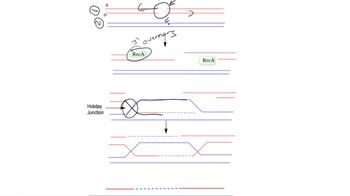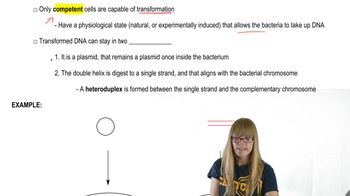Table of contents
- 1. Introduction to Genetics51m
- 2. Mendel's Laws of Inheritance3h 37m
- 3. Extensions to Mendelian Inheritance2h 41m
- 4. Genetic Mapping and Linkage2h 28m
- 5. Genetics of Bacteria and Viruses1h 21m
- 6. Chromosomal Variation1h 48m
- 7. DNA and Chromosome Structure56m
- 8. DNA Replication1h 10m
- 9. Mitosis and Meiosis1h 34m
- 10. Transcription1h 0m
- 11. Translation58m
- 12. Gene Regulation in Prokaryotes1h 19m
- 13. Gene Regulation in Eukaryotes44m
- 14. Genetic Control of Development44m
- 15. Genomes and Genomics1h 50m
- 16. Transposable Elements47m
- 17. Mutation, Repair, and Recombination1h 6m
- 18. Molecular Genetic Tools19m
- 19. Cancer Genetics29m
- 20. Quantitative Genetics1h 26m
- 21. Population Genetics50m
- 22. Evolutionary Genetics29m
5. Genetics of Bacteria and Viruses
Bacterial Conjugation
Problem 1g
Textbook Question
In this chapter, we have focused on genetic systems present in bacteria and on the viruses that use bacteria as hosts (bacteriophages). In particular, we discussed mechanisms by which bacteria and their phages undergo genetic recombination, which allows geneticists to map bacterial and bacteriophage chromosomes. In the process, we found many opportunities to consider how this information was acquired. From the explanations given in the chapter, what answers would you propose to the following questions? How do we know whether or not genetic recombination between bacteria involves cell-to-cell contact?
 Verified step by step guidance
Verified step by step guidance1
Step 1: Understand the concept of genetic recombination in bacteria, which can occur through processes such as transformation, transduction, and conjugation.
Step 2: Focus on conjugation, a process that requires direct cell-to-cell contact for the transfer of genetic material between bacterial cells.
Step 3: Consider the historical experiments by Lederberg and Tatum, who demonstrated that genetic recombination in bacteria required physical contact between cells by using a U-tube experiment.
Step 4: In the U-tube experiment, a filter was placed between two bacterial strains that allowed the passage of molecules but not cells. No recombination was observed, indicating that direct contact was necessary.
Step 5: Conclude that the requirement of cell-to-cell contact for genetic recombination in bacteria is evidenced by the inability of recombination to occur when physical separation is maintained, as shown in the U-tube experiment.
Recommended similar problem, with video answer:
 Verified Solution
Verified SolutionThis video solution was recommended by our tutors as helpful for the problem above
Video duration:
1mPlay a video:
Was this helpful?
Key Concepts
Here are the essential concepts you must grasp in order to answer the question correctly.
Genetic Recombination
Genetic recombination is a process where genetic material is exchanged between organisms, leading to new genetic combinations. In bacteria, this can occur through mechanisms such as transformation, transduction, and conjugation. Understanding these processes is crucial for determining how genetic traits are shared and how they can influence bacterial evolution and adaptation.
Recommended video:
Guided course

Recombination after Double Strand Breaks
Conjugation
Conjugation is a specific type of genetic recombination in bacteria that requires direct cell-to-cell contact. During this process, one bacterium transfers genetic material to another through a structure called a pilus. This mechanism is essential for understanding how certain traits, such as antibiotic resistance, can spread rapidly among bacterial populations.
Recommended video:
Guided course

Conjugation Overview
Experimental Evidence
To determine whether genetic recombination between bacteria involves cell-to-cell contact, scientists conduct experiments that manipulate conditions, such as using filters to separate cells. By observing whether recombination occurs in the absence of direct contact, researchers can infer the mechanisms involved. This experimental approach is fundamental in genetics to validate hypotheses about bacterial behavior and genetic exchange.
Recommended video:
Guided course

Transformation

 4:06m
4:06mWatch next
Master Conjugation Overview with a bite sized video explanation from Kylia Goodner
Start learning


